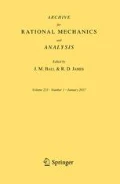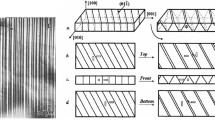Abstract
In this paper we investigate the X-interface, a microstructure observed in Indium-Thallium byBasinski &Christian [5].Ball &James [3] have shown howsimple martensitic microstructures can be represented by sequences of elastic deformations which minimise a free-energy functional. In contrast we show that the X-interfacecannot be represented by such a sequence. In an attempt to understand this result we develop a less restrictive theory based onEricksen's ideas about low-energy modes of deformation for martensitic materials. This theory has some interesting conclusions for the X-interface and Indium-Thallium, for the wedge-like microstructures analysed recently byBhattacharya [6], and for the general problem of microstructures which cannot be represented by minimising sequences. The calculations in this paper apply only to cubic-to-tetragonal transformations.
Similar content being viewed by others
References
R. Adams.Sobolev spaces. Academic Press, 1975.
J. M. Ball. A version of the fundamental theorem for Young measures.Partial differential Equations and Continuum Models of Phase Transitions, eds:M. Rascle, D. Serre &M. Slemrod. Springer Lecture Notes in Physics,344: 207–215, 1989.
J. M. Ball &R. D. James. Fine phase mixtures as minimizers of energy.Archive for Rational Mechanics and Analysis,100: 13–52, 1987.
J. M. Ball &R. D. James. Proposed experimental tests of a theory of fine microstructure and the two-well problem.Philosophical Transactions of the Royal Society of London A,338: 389–450, 1992.
Z. S. Basinski &J. W. Christian. Crystallography of deformation by twin boundary movements in Indium-Thallium.Acta Metallurgica,2: 101–116, 1954.
K. Bhattacharya. Wedge-like microstructure in martensites.Acta Metallurgica et Materialia,39: 2431–2444, 1991.
K. Bhattacharya. Comparison of the geometrically linear and nonlinear theories of martensitic transformation.Continuum Mechanics and Thermodynamics,5: 205–242, 1993.
J. S. Bowles &J. K. Mackenzie. The crystallography of martensitic transformations I and II.Acta Metallurgica,2: 129–137, 138–147, 1954.
M. Chipot &D. Kinderlehrer. Equilibrium configurations of crystals.Archive for Rational Mechanics and Analysis,103: 237–277, 1988.
C. Collins &M. Luskin. The computation of the austenitic-martensitic phase transition.Partial Differential Equations and Continuum Models of Phase Transitions, Springer Lecture Notes in Physics,344: 1989.
N. Dunford &J. T. Schwartz.Linear Operators, Part I. Interscience, 1967.
J. L. Ericksen. Some surface defects in unstressed thermoelastic solids.Archive for Rational Mechanics and Analysis,88: 337–345, 1985.
J. L. Ericksen. Constitutive theory for some constrained elastic crystals.International Journal of Solids and Structures,22: 951–964, 1986.
J. L. Ericksen. Weak martensitic transformations in Bravais lattices.Archive for Rational Mechanics and Analysis,107: 23–36, 1989.
J. L. Ericksen. Bifurcation and martensitic transformations in Bravais lattices.Journal of Elasticity,28: 55–78, 1992.
J. D. Eshelby. Elastic inclusions and inhomogeneities.Progress in Solid Mechanics, Vol. 2, eds.I. N. Sneddon &R. Hill, 1961.
M. E. Gurtin. Two-phase deformations of elastic solids.Archive for Rational Mechanics and Analysis,84: 1–29, 1983.
A. G. Khachaturyan. Some questions concerning the theory of phase transitions in solids.Soviet Physics-Solid State,8: 2163–2168, 1967.
A. G. Khachaturyan.Theory of Structural Transformations in Solids. Wiley, 1983.
A. G. Khachaturyan &G. A. Shatalov. Theory of macroscopic periodicity for a phase transition in the solid state.Soviet Physics JETP,29: 557–561, 1969.
R. V. Kohn. The relaxation of a double well energy,Continuum Mechanics and Thermodynamics,3: 193–236, 1991.
A. L. Roitburd. Orientational and habit relationships between crystalline phases in solid state transformations.Sov. Phys. Crystallography,12: 499–504, 1967.
A. L. Roitburd. Martensitic transformation as a typical phase transformation in solids.Solid State Physics,33: 317–390, 1978.
L. Tartar. Compensated compactness and applications to partial differential equations.Nonlinear Analysis and Mechanics, ed.R. J. Knops, Pitman 1978.
M. S. Wechsler, D. S. Lieberman &T. A. Read. On the theory of the formation of martensite.Trans. AIME J. Metals,197: 1503–1515, 1953.
Author information
Authors and Affiliations
Additional information
Communicated by R. D. James
Rights and permissions
About this article
Cite this article
Ruddock, G. A microstructure of martensite which is not a minimiser of energy: the X-interface. Arch. Rational Mech. Anal. 127, 1–39 (1994). https://doi.org/10.1007/BF01845216
Accepted:
Issue Date:
DOI: https://doi.org/10.1007/BF01845216




